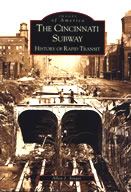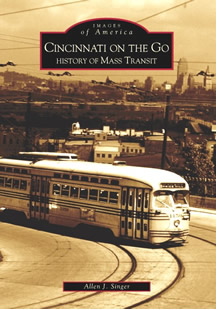Stepping Out in Cincinnati FAQ
Why the title?
During the period this book covers, “stepping out” meant to go out dancing. The title was partially inspired by the 1942 song Let Me off Uptown by Anita O’Day, which includes the line “If you feel like stepping out.” Today we say “going out.”What inspired the book?
A few months after Subway came out I was toying with the idea of writing a book solely about Prohibition in Cincinnati, with a focus on speakeasies. Cliff Radel of the Cincinnati Enquirer wrote an article about it, which brought me a selection of stories and locations and contacts. However, I could not find any actual pictures of speakeasies. While the stories came in, I researched Prohibition and accumulated a binder full of information. At the end of 2003 I proposed a sequel to Subway and soon made Cincinnati on the Go, which was released in October, 2004. Afterwards, I started thinking of using the research I gathered for the defunct speakeasy book for a book on entertainment history. Arcadia was interested, so I wrote Stepping Out in Cincinnati.
Why the topics?
I wanted to cover a range of topics including movie theaters, Prohibition, nightclubs, orchestras, Newport gambling, burlesque and vaudeville, black entertainment, and radio and television. These subjects were dependent on the varieties and sources of photos, as I would need at least 200-220 images for the book. What was important to me was a good variety of interesting pictures for each topic.
Where did you find the pictures?
I first contacted everyone I had spoken to for the first two books. Earl Clark, a musician and transportation historian, had some nice orchestra pictures and gave me names of other people to contact, which included Eugene Frye at the Musicians’ Union. Mr. Frye let me borrow rare photos from the Union, and gave me additional names to call. Dan Finfrock, the railroadiana collector who helped with the second book gave me a batch of never-before-seen pictures of vaudeville and burlesque shows and city scenes taken by photographer Ed Kuhr in the 1930s. Bill Myers, whose grandfather photographed the city in the 1920s and ‘30s, lent me a collection of negatives of downtown theaters. Cincinnatihistory.com provided more theater pictures taken by photographer Ben Rosen. The Cincinnati Arts Consortium donated a batch of photos of various black entertainment venues. Pictures of two Price Hill theaters came from the Price Hill Historical Society. Newspaper cartoons were copied from Cincinnati Post microfilm and were cleaned up by my sister using Photoshop. Cincinnativiews.net provided saloon postcard images and nkyviews.com gave me postcard images of Northern Kentucky clubs. Veteran broadcaster Bill Nimmo lent some of his irreplaceable pictures for the radio/tv chapter. Bill Myers had slides of behind the scenes at Channel 5 when he worked there in the 1950s. Other pictures came from individual collectors and the Historical Society.Where did you find the information?
Books, newspaper microfilm, interviews and the web. What was important in this work was to offer more than an assortment of pictures of theaters and label each as such. Therefore, I spent many hours at the library researching newspaper articles and advertisements featuring theaters and other entertainment events. I wanted to tell as much of a theater or other venues’ histories as possible. Each chapter opens with about 1,500 words of introduction, which gives a social history mixed in with the city history. The focus is on people. What did people do for entertainment? Where did they go? What did they experience? How was entertainment different in the 1920s and ‘30s compared to today? For this information I went to the source: newspaper articles and personal interviews. For the black entertainment chapter, I met a man who was a self-described “amateur historian” who told me the history of black people in Cincinnati: how and where they lived, their treatment by white Cincinnati, and how they found their entertainment. Much of what he told me I had never heard before and is not covered in any book. This history should be a “first” for black Cincinnatians.
How in-depth is it?
I covered as much as I could given the space available and resources at hand. I have over fifty movie-theater related images. I would have loved to feature every single movie house that ever existed in Cincinnati, but could only show those which I had access to. The results are pretty comprehensive, though.
What’s next?
Regarding Arcadia titles, I prefer doing “theme” books instead of a town’s history. So far I’ve covered transportation and entertainment. I don’t wish to pigeonhole my writing career in just history, but since I enjoy it I am currently writing a children’s chapter book set at the end of World War II—obviously not an Arcadia book. I have other things in mind that are far removed from history and/or Arcadia, so we’ll see what the future brings.

